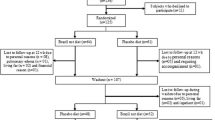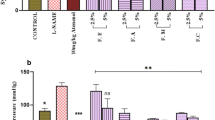Abstract
Oxygen-free radicals and other oxygen/nitrogen species are constantly generated in the human body. Most are intercepted by antioxidant defences and perform useful metabolic roles, whereas others escape to damage biomolecules like DNA, lipids and proteins. Garlic has been shown to contain antioxidant phytochemicals that prevent oxidative damage. These include unique water-soluble organosulphur compounds, lipid-soluble organosulphur compounds and flavonoids. Therefore, in the present study, we have tried to explore the antioxidant effect of garlic supplementation on oxidative stress-induced DNA damage, nitric oxide (NO) and superoxide generation and on the total antioxidant status (TAS) in patients of essential hypertension (EH). Twenty patients of EH as diagnosed by JNC VI criteria (Group I) and 20 age and sex-matched normotensive controls (Group II) were enrolled in the study. Both groups were given garlic pearls (GP) in a dose of 250 mg per day for 2 months. Baseline samples were taken at the start of the study, i.e. 0 day, and thereafter 2 months follow-up. 8-Hydroxy-2′-deoxyguanosine (8-OHdG), lipids, lipid peroxidation (MDA), NO and antioxidant vitamins A, E and C were determined. A moderate decline in blood pressure (BP) and a significant reduction in 8-OHdG, NO levels and lipid peroxidation were observed in Group I subjects with GP supplementation. Further, a significant increase in vitamin levels and TAS was also observed in this group as compared to the control subjects. These findings point out the beneficial effects of garlic supplementation in reducing blood pressure and counteracting oxidative stress, and thereby, offering cardioprotection in essential hypertensives.
Similar content being viewed by others
References
Dates JA: Antihypertensive agents and the drug therapy of hypertension. In: P.B. Molinoff, R.V. Ruddom (eds). Goodman Gilman’s. The Pharmacological Basis of Therapeutics, 9th edn., Mc-Graw Hill, New~York, 1996, pp 780–800
Williams GH: Hypertensive vascular diseases. In: K. Isselbacher, E. Braunwald, J.D. Wilson et~al. (eds). Harrison’s Principles of Internal Medicine, 14th edn., McGraw-Hills, New York, 1967, pp 1380–1394
Leuritzen CL: Hypertension and pregnancy. In: J. Rosenthal (ed). Arterial Hypertension, Pathogenesis, Diagnosis and Therapy, Springer Verlag, New York, 1982, pp 102–116
Raptis S: Hypertension and diabetes mellitus. In: J. Rosenthal (ed). Arterial Hypertension, Pathogenesis, Diagnosis and Therapy, Springer Verlag, New York, 1982, pp 93–100
Weschsler J, Bitschunert H: Hypertension and obesity. In: J. Rosenthal (ed). Arterial Hypertension Pathogenesis, Diagnosis and Therapy. Springer Verlag, New York, 1982, pp 62–78
Helmut S: Oxidative stress: from basic research to clinical applications. Am J Med 30: 3031S–3037S, 1991
Dhalla NS, Temsah RM, Natticaden T: Role of oxidative stress in cardiovascular diseases. J Hypertens 18: 655–673, 2000
Halliwell B: Oxidants and human diseases: Some new concepts. FASEB 5: 358–364, 1987
Ames BN, Shigenaga MK, Hagen TM: Oxidants, antioxidants and the degenerative diseases of ageing. PNAS 90: 7915–7922, 1993
Tagami M, Yamagata K, Fujino H, Nara Y, Nakagawa K, Kubota A, Numano F, Yamori Y: Genetic vulnerability of cortical neurons isolated from stroke-prone spontaneously hypertensive rats in hypoxia and oxygen reperfusion. Hypertens Res 22: 23–29, 1999
Lacy F, O’Connor D, Schmid-Schenbein G: Plasma hydrogen peroxide production in hypertensives and normotensive subjects at genetic risk of hypertension. J Hypertens 16: 291–303, 1998
Russo C, Olivieri O, Girelli D, Faccini G, Zennari LM, Lombardi S, Corrocher R: Antioxidant status and lipid peroxidation in patients with essential hypertension. J Hypertens 16: 1267–1271, 1998
Dample B, Harrison L: Repair of oxidative damage to DNA: Enzymology and biology. Ann Rev Biochem 63: 915–924, 1994
Halliwell B: Can oxidative DNA damage be used as a biomarker of cancer risk in humans? Free Radic Res 22: 23–29, 1998
Birmhom HK: The production of DNA strand breaks in human leukocytes by superoxide anion. Proc Natl Acad Sci USA 82: 80–88, 1985
Kasai H: Analysis of a form of oxidative DNA damage, 8-hydroxy-2′ deoxyguanosine, as a marker of cellular oxidative stress during carcinogenesis. Mutat Res 387: 146–163, 1997
Totter HR: Spontaneous cancer and its possible relationship to oxygen metabolism. Proc Natl Acad Sci USA 77: 1763–1767, 1980
Burdon RH, Allingana D, Gill V: Endogenously generated active oxygen species and cellular glutathione levels in relation to BHK-21 cell proliferation. Free Radic Res 21: 121–134, 1994
Feig DI, Loeb LA: Mechanisms of mutation by oxidative DNA damage, reduced fidelity of mammalian DNA polymerase. J Biochem 32: 4466–4473, 1993
Chaudhary AK, Nokubo M, Reddy GR, et~al.: Detection of endogenous malondialdehyde deoxy-guanosine adducts in human liver. Science 265: 1580–1582, 1994
EL Ghissassi F, Barbin A, Nair J, Bartsch H: Formation of 1N6-ethenoadenine and 3,N4-ethenocytosine by lipid peroxidation products and nucleic acid bases. Chem Res Toxicol 8: 278–283, 1995
Simic MG: Urinary biomarkers and the rate of DNA damage in carcinogenesis. Mutat Res 267: 277–290, 1992
Loft S, Vistisen K, Ewertz MT, Jonneland A, Overad K, Poulsen E: Oxidative DNA damage estimated by 8-hydroxydeoxyguanosine excretions in humans. Influence of smoking, gender and body mass index. Carcinogenesis 13: 2241–2247, 1992
Loft S, Deng XS, Tuo J: Experimental study of oxidative DNA damage. Free Radic Res 29: 525–539, 1993
Mo Jim Maki H, Sakiguchi M: Hydrolytic elimination of a mutagenic nucleotide 8-oxod GTP by human 18-KDa protein: sensitisation of nucleotide pool. Proc Soc Natl Acad Sci USA 89: 11021–11025, 1992
Shigenaga M, Gimeno C, Ames B: Urinary 8-hydroxy 2′-deoxyguano- sine as a biological marker of in vivo oxidative DNA damage. Proc Soc Natl Acad Sci USA 86: 9697–9701, 1989
Yeh Y-Y, Lijuan L: Cholesterol lowering effects of garlic extracts an organosulfur compounds: human and animal studies. J Nutr 131: 989S–993S, 2001
Koscielny J, Klussendorf D, Schmidt R, Radtke H, Siegel G, Kiesewetter H: Study of garlic extracts and fractions on cholesterol plasma levels and vascular reactivity in cholesterol-fed rats. J Nutr 131: 994S–999S, 2001
Spigelski D, Jones Peter JH: Efficacy of garlic supplementation in lowering serum cholesterol levels. Nutr Rev 59: 236–241, 2001
Foushee DB, Ruffin J, Banerjee U: Garlic as a natural agent for the treatment of hypertension: A preliminary report. Cytobios 34: 145–152, 1982
Steiner M, Li W: Aged garlic as a modulator of cardiovascular risk factors: Adose finding study on the effects of AGE on platelet function. J Nutr 131: 980S–984S, 2001
Bordia A, Verma SK, Srivastava KC: Effect of garlic (Allium sativum) on blood lipids, blood sugar, fibrinogen and fibrinolytic activity in patients of coronary heart disease. Prostaglandins. Leuk Essential Fatty acids 58: 257, 1998
Prasad K, Lax dal VA, Yu M, Rancy BL: Antioxidant activity of allicin, an active principle in garlic. Mol Cell Biochem 148: 183, 1995
The Sixth Report of Joint National Committee on prevention, detection, evaluation and treatment of high blood pressure. Arch Intern Med 157: 2401–2445, 1997
Green LC, Wagner DA, Glagowski J, Skipper PL, Wishnak JS, Tannenbaum SR: Analysis of nitrate, nitrite and [15N] nitrate in biological fluids. Anal Biochem 126: 131–138, 1982
Boyde TRC, Rahmatullah M: Optimisation of conditions for colorimetric determination of citrulline using diacetyl monoxime. Anal Biochem 107: 424–431, 1980
Thurnham DI, Smith E, Flora SP: Concurrent liquid chromatographic assay of retinol, α-tocopherol, carotene, cryptoxanthin in plasma with tocopherol acetate as internal standard. Clin Chem 34: 377–381, 1988
Margolis SA, Paule RC, Ziegler RG: Ascorbic and dehydroascorbic acids measured in plasma preserved with dithiothreitol or metaphosphoric acid. Clin Chem 36: 1750–1755, 1990
Benzie FF, Strain JJ: Ferric reducing/antioxidant power assay: Direct measure of total antioxidant activity of biological fluids and modified version for simultaneous measurement of total antioxidant power and ascorbic acid concentration. Anal Biochem 239: 15–27, 1996
Boyum A: Isolation of mononuclear cells and granulocytes from human blood. Scand J Clin Invest 21: 77–89, 1968
Cheung K, Archibald AC, Robinson MF: Luminol-dependent chemiluminescence produced by PMNL’s stimulated by immune complex. Aust J Exp Biol Med Sci 62: 403–419, 1984
Clerc M, Peuchant E, Carbonneau MA, Sess D: Free and bound malondialdehyde measured as thiobarbituric acid adduct by HPLC in serum and plasma. Clin Chem 37: 1423–1429, 1991
Lahiri DK, Bye S, Nurnber JL, Hodes ME, Crisp M: A non-organic and non-enzymatic extraction method gives higher yield of genomic DNA from whole blood sample than do other methods tested. J Biochem Biophys Methods 25: 193–205, 1992
Maniatis T, Sambrook J, Fritch EF: Molecular Cloning: A Laboratory Manual, 2nd edn., Cold Spring Harbor Laboratory Press, Cold Spring Harbor, NY, 1989, pp 6.3–6.4
Whetton PK: Epidemiology of hypertension. Lancet 344: 101–106, 1994
Silaqy CA, Neil HAW: A meta analysis of the effect of garlic on blood pressure. J Hypertens 12: 463–468, 1994
Siegel G, Nuck R, Schnalke F, Michel F: Molecular evidences for phytopharmacological K channel opening by garlic in human vascular smooth muscle cell membranes. Phytother Res 12: S149–S151, 1998
Suetsuna K: Isolation and characterization of angiotensin 1 converting enzyme inhibitor peptides derived from Allium sativum L (garlic). J Nutr Biochem 9: 415–419, 1998
Pedraza-Chaverri J, Tapia E, Medina Campus ON: Garlic prevents hypertension by chronic inhibition of nitric oxide synthesis. Life Sci 62: 71–72, 1998
Mc Intyre M, Hamilton CA, Rees DD, Reid JL, Dominiczac AF: Sex differences in the abundance of endothelial nitric oxide in a model of hypertension. Hypertension 30: 1517–1524, 1997
Vaziri ND, Ni Z, Ovesi F: Upregulation of renal and vascular nitric oxide synthase in young spontaneously hypertensive rats. Hypertension 31: 1248–1254, 1998
Luscher TF: Imbalance between endothelium-derived relaxing and contracting factors: A new concept in hypertension. Am J Hypertens 4: 317–330, 1990
Gryglewski RJ, Palmer RMJ, Moncada S: Superoxide anion is involved in the breakdown of endothelium-derived vascular relaxing factor. Nature 320: 454–456, 1986
Salahudeen AK: Role of lipid peroxidation in H2O2-induced renal epithelial (LLK-PK) cell injury. Am J Physiol 268: F30–F38, 1995
Takabashi K, Nammour TRM, Fukunaga M, Ebert J, Murrow JD, Hoover RL, Badr K: Glomerular action of a free radical-generated novel prostaglandin, 8-epi prostaglandin, 8-epi-PGF2α in the rat: Evidence for interaction with thromboxane A2 receptors. J Clin Invest 90: 136–141, 1992
Lin PJ, Pearson PJ, Cartier R, Schaff HV: Superoxide anion mediates the endothelium-dependent contraction to serotonin by regenerated endothelium. Thorac Cardiovasc Surg 102: 378–385, 1991
Tesfamariam B, Cohen RA: Role of Superoxide anion and endothelium in vasoconstrictor action of prostaglandin endoperoxide. Am J Physiol 262: H1915–H1919, 1992
Vaziri ND, Wang XQ: cGMP-mediated negative feedback regulation of endothelial nitric oxide synthase expression by nitric oxide. Hypertension 34: 1237–1241, 1999
Attri J, Dhawan V, Mahmood S, Pandhi P, Parwana HK, Nath R: Effect of vitamin C supplementation on oxidative DNA damage in an experimental model of lead-induced hypertension. Ann Nutr Metab 47: 294–301, 2003
Negishi H, Njelekela M, Ikeda K, Sagara M, Noguchi T, Kuga S: Assessment of in vivo oxidative stress in hypertensive rats and hypertensive subjects in Tanzania, Africa. Hypertens Res 23: 285–289, 2000
Inoue S, Kawanishi S: Oxidative DNA damage induced by simultaneous generation of nitric oxide and superoxide. FEBS Lett 371: 86–88, 1995
Kumar KU, Das UN: Are free radicals involved in the pathophysiology of human essential hypertension? Free Radic Res Commun 19: 59–66, 1993
Singal PK, Khaper N, Palace U, Kumar D: The role of oxidative stress in the genesis of heart disease. Cardiovasc Res 40: 426–432, 1998
Dhawan V, Jain S: Effect of garlic supplementation on oxidized low-density lipoproteins and lipid peroxidation in patients of essential hypertension. Mol Cell Biochem 166: 115–119, 2000
Author information
Authors and Affiliations
Corresponding author
Rights and permissions
About this article
Cite this article
Dhawan, V., Jain, S. Garlic supplementation prevents oxidative DNA damage in essential hypertension. Mol Cell Biochem 275, 85–94 (2005). https://doi.org/10.1007/s11010-005-0824-2
Received:
Accepted:
Issue Date:
DOI: https://doi.org/10.1007/s11010-005-0824-2




